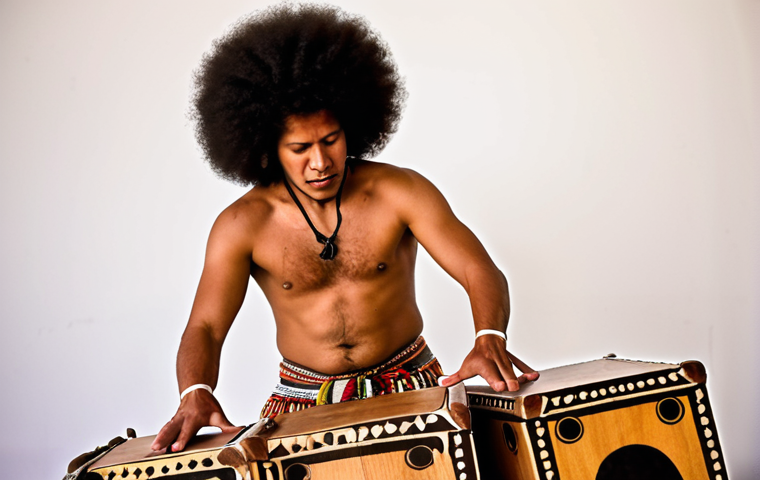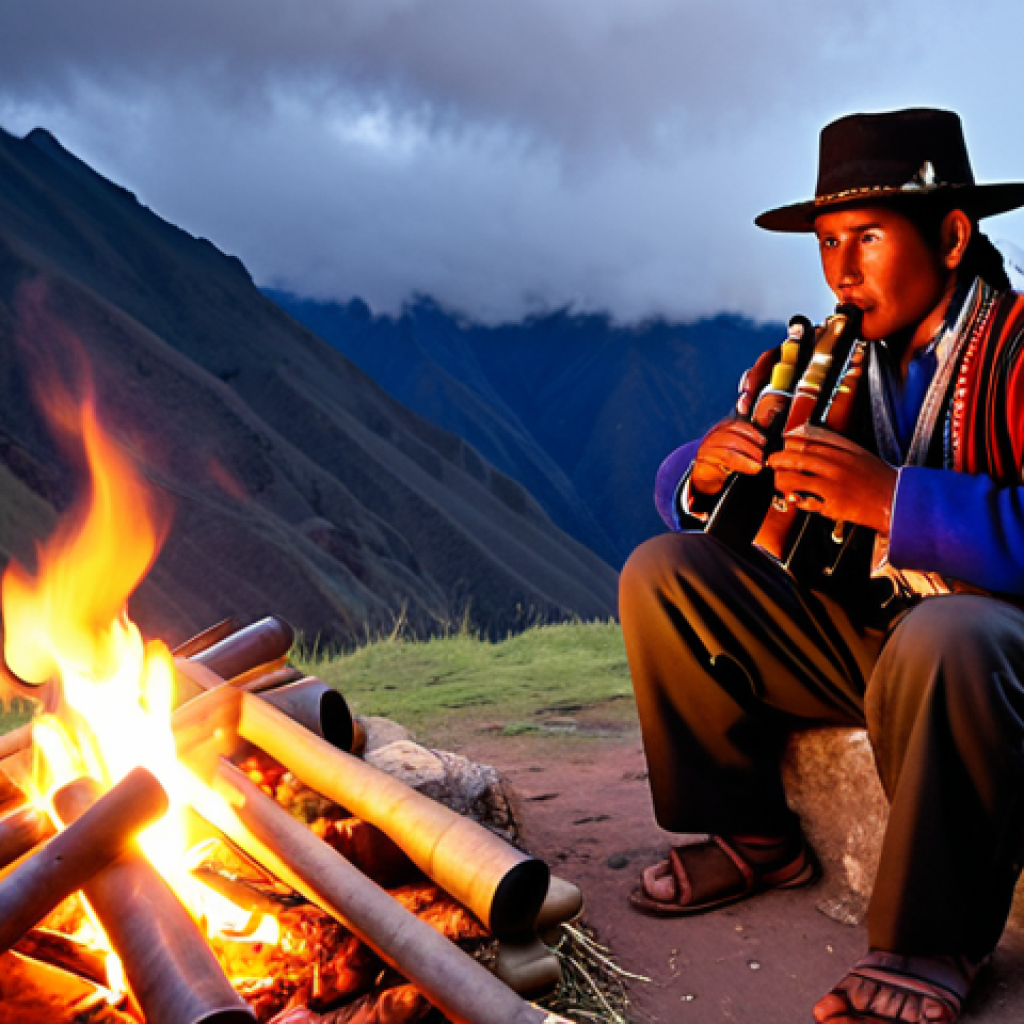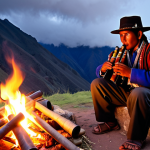Peru, a land brimming with ancient history and breathtaking landscapes, also boasts a vibrant musical heritage that’s truly captivating. From the soaring melodies of Andean panpipes to the infectious rhythms of Afro-Peruvian beats, the music scene here is a melting pot of influences.
Imagine strolling through the streets of Cusco and hearing the haunting sounds of a “quena” flute drifting from a nearby courtyard – it’s an experience that stays with you.
I’ve always been drawn to music that tells a story, and Peruvian traditional music definitely does that, weaving tales of resilience, love, and connection to the land.
Let’s delve deeper and get to the heart of it all in the article below!
Unearthing the Soulful Melodies of the Andes

Peruvian music is deeply intertwined with the Andean landscape. The mountains, the valleys, the very air seems to vibrate with its rhythms. When I trekked the Inca Trail a few years ago, I remember sitting by the campfire one night, listening to a local guide play a haunting melody on his “zampona,” a type of panpipe.
It was as if he was channeling the spirits of the ancient Incas themselves. The music spoke of the land, of its history, and of the resilience of its people.
The Haunting Sound of the Quena Flute
The quena, a notched flute traditionally made from bone or cane, is another iconic Andean instrument. Its melancholic tone is instantly recognizable, evoking feelings of longing and nostalgia.
I once stumbled upon a small artisan shop in the Sacred Valley where an elderly man was crafting quenas. He explained to me that each flute has its own unique voice, shaped by the materials used and the skill of the maker.
Rhythmic Footprints of the Tinya Drum
The tinya drum, a small, hand-held drum, provides the heartbeat for many Andean musical traditions. Its steady rhythm is both grounding and uplifting, inviting listeners to move and connect with the music.
During a festival in a remote mountain village, I witnessed a group of women playing tinyas while dancing in a circle. The energy was infectious, and I couldn’t help but join in, feeling a sense of community and shared joy.
Exploring the Afro-Peruvian Rhythms from the Coast
While the Andes Mountains hold a significant place in Peruvian musical identity, the coastal regions have also contributed to a vibrant Afro-Peruvian musical heritage.
Descendants of enslaved Africans brought their traditions to Peru, blending them with indigenous and European influences. The result is a unique and powerful sound that celebrates resistance, resilience, and cultural fusion.
The Cajón: A Percussive Storyteller
The cajón, a wooden box drum, is perhaps the most iconic Afro-Peruvian instrument. It’s played by striking the front surface with the hands, producing a range of percussive sounds that mimic a full drum kit.
I remember attending a concert in Lima where a cajón master demonstrated the instrument’s versatility, creating intricate rhythms and improvisations that left the audience spellbound.
It truly felt like the cajón was telling a story of its own.
The Sensual Dance of the Festejo
Festejo is a lively and energetic Afro-Peruvian dance and musical genre. It’s characterized by its fast-paced rhythms, syncopated percussion, and passionate vocals.
The dance itself is full of playful interactions and flirtatious movements, reflecting the joy and celebration of life. I took a Festejo dance class once, and it was an incredible experience to feel the rhythm coursing through my veins, connecting me to a rich cultural heritage.
Contemporary Fusion: Bridging Tradition and Innovation
Peruvian music isn’t just about preserving the past; it’s also about embracing the future. Many contemporary musicians are blending traditional sounds with modern genres, creating innovative and exciting new music.
Electronic Beats and Andean Instruments
I’ve been following a few Peruvian DJs who are incorporating Andean instruments like the quena and zampona into their electronic music. It’s a fascinating fusion that creates a unique and atmospheric soundscape.
I discovered one artist through a small club in Barranco, Lima. The blend of ancient melodies with modern beats is surprisingly effective, attracting a diverse audience of both locals and tourists.
Jazz Harmonies and Afro-Peruvian Rhythms
Several Peruvian jazz musicians are exploring the intersection of jazz harmonies and Afro-Peruvian rhythms. They are composing original pieces that showcase the improvisational spirit of jazz while also celebrating the cultural richness of Afro-Peruvian music.
I had the pleasure of seeing a jazz ensemble perform in Miraflores, and their music was both sophisticated and deeply rooted in Peruvian identity.
Experiencing Peruvian Music Firsthand
The best way to truly appreciate Peruvian music is to experience it firsthand. Whether you’re attending a concert, taking a dance class, or simply listening to street musicians, immersing yourself in the local music scene is an unforgettable experience.
Festivals and Celebrations
Peru is home to numerous festivals and celebrations throughout the year, many of which feature traditional music and dance. Inti Raymi, the Festival of the Sun, is a spectacular event held in Cusco every June, showcasing the rich cultural heritage of the Inca Empire.
The Marinera Festival in Trujillo is another must-see event, celebrating the elegant and graceful Marinera dance.
Finding Local Gigs and Concerts
Check local listings for live music venues and concerts. Many cities in Peru have vibrant music scenes, with venues showcasing both traditional and contemporary music.
Talk to locals and ask for recommendations – they’ll often know about hidden gems and up-and-coming artists. My favorite approach has been to simply wander and listen.
You’ll often stumble upon something special!
The Instruments That Define Peruvian Music
To fully appreciate the music, understanding the instruments used is key. Here’s a quick guide:
| Instrument | Origin | Description | Sound Characteristic |
|---|---|---|---|
| Quena | Andean | Notched flute made of bone or cane | Melancholic, haunting |
| Zampona | Andean | Panpipes | Soaring, airy |
| Cajón | Afro-Peruvian | Wooden box drum | Percussive, versatile |
| Tinya | Andean | Hand-held drum | Rhythmic, grounding |
| Charango | Andean | Small lute-like stringed instrument | Bright, cheerful |
Where to Buy Authentic Peruvian Music
For those looking to bring a piece of Peruvian music home, several options are available for purchasing authentic recordings.
Local Markets and Artisan Shops
Wander through local markets in cities like Cusco or Lima. You’ll often find vendors selling CDs and cassettes of traditional Peruvian music. Artisan shops may also offer recordings by local musicians.
Bargaining is common in these markets, so don’t be afraid to negotiate the price. I always enjoy flipping through the crates of CDs – you never know what treasures you might find!
Specialty Music Stores
In larger cities, look for specialty music stores that focus on Peruvian and Latin American music. These stores often have a curated selection of high-quality recordings, including albums by well-known artists and emerging talents.
The staff can also provide recommendations based on your musical preferences.
Online Resources
Several online retailers specialize in Peruvian music. Websites like Amazon or specialized online music stores often carry a wide range of Peruvian music CDs and digital downloads.
You can also find recordings on streaming services like Spotify and Apple Music, allowing you to sample different artists before making a purchase.
Supporting Peruvian Musicians
One of the best ways to appreciate Peruvian music is to support the musicians who create it. By attending concerts, purchasing their music, and spreading the word about their work, you can help ensure that these traditions continue to thrive.
Attend Local Concerts and Shows
Whenever possible, attend local concerts and shows featuring Peruvian musicians. This is a great way to experience the music live and support the artists directly.
Check local event listings and social media for upcoming performances.
Purchase Their Music Directly
Buy CDs, digital downloads, or vinyl records directly from the musicians whenever possible. This ensures that they receive the largest share of the profits.
Many musicians sell their music at concerts or through their websites.
Spread the Word About Their Work
Share your favorite Peruvian music with friends and family. Write reviews of their albums or concerts on social media. By spreading the word, you can help increase their visibility and attract new fans.
Unearthing the Soulful Melodies of the Andes
Peruvian music is deeply intertwined with the Andean landscape. The mountains, the valleys, the very air seems to vibrate with its rhythms. When I trekked the Inca Trail a few years ago, I remember sitting by the campfire one night, listening to a local guide play a haunting melody on his “zampona,” a type of panpipe. It was as if he was channeling the spirits of the ancient Incas themselves. The music spoke of the land, of its history, and of the resilience of its people.
The Haunting Sound of the Quena Flute
The quena, a notched flute traditionally made from bone or cane, is another iconic Andean instrument. Its melancholic tone is instantly recognizable, evoking feelings of longing and nostalgia. I once stumbled upon a small artisan shop in the Sacred Valley where an elderly man was crafting quenas. He explained to me that each flute has its own unique voice, shaped by the materials used and the skill of the maker.
Rhythmic Footprints of the Tinya Drum
The tinya drum, a small, hand-held drum, provides the heartbeat for many Andean musical traditions. Its steady rhythm is both grounding and uplifting, inviting listeners to move and connect with the music. During a festival in a remote mountain village, I witnessed a group of women playing tinyas while dancing in a circle. The energy was infectious, and I couldn’t help but join in, feeling a sense of community and shared joy.
Exploring the Afro-Peruvian Rhythms from the Coast
While the Andes Mountains hold a significant place in Peruvian musical identity, the coastal regions have also contributed to a vibrant Afro-Peruvian musical heritage. Descendants of enslaved Africans brought their traditions to Peru, blending them with indigenous and European influences. The result is a unique and powerful sound that celebrates resistance, resilience, and cultural fusion.
The Cajón: A Percussive Storyteller
The cajón, a wooden box drum, is perhaps the most iconic Afro-Peruvian instrument. It’s played by striking the front surface with the hands, producing a range of percussive sounds that mimic a full drum kit. I remember attending a concert in Lima where a cajón master demonstrated the instrument’s versatility, creating intricate rhythms and improvisations that left the audience spellbound. It truly felt like the cajón was telling a story of its own.
The Sensual Dance of the Festejo
Festejo is a lively and energetic Afro-Peruvian dance and musical genre. It’s characterized by its fast-paced rhythms, syncopated percussion, and passionate vocals. The dance itself is full of playful interactions and flirtatious movements, reflecting the joy and celebration of life. I took a Festejo dance class once, and it was an incredible experience to feel the rhythm coursing through my veins, connecting me to a rich cultural heritage.
Contemporary Fusion: Bridging Tradition and Innovation
Peruvian music isn’t just about preserving the past; it’s also about embracing the future. Many contemporary musicians are blending traditional sounds with modern genres, creating innovative and exciting new music.
Electronic Beats and Andean Instruments
I’ve been following a few Peruvian DJs who are incorporating Andean instruments like the quena and zampona into their electronic music. It’s a fascinating fusion that creates a unique and atmospheric soundscape. I discovered one artist through a small club in Barranco, Lima. The blend of ancient melodies with modern beats is surprisingly effective, attracting a diverse audience of both locals and tourists.
Jazz Harmonies and Afro-Peruvian Rhythms
Several Peruvian jazz musicians are exploring the intersection of jazz harmonies and Afro-Peruvian rhythms. They are composing original pieces that showcase the improvisational spirit of jazz while also celebrating the cultural richness of Afro-Peruvian music. I had the pleasure of seeing a jazz ensemble perform in Miraflores, and their music was both sophisticated and deeply rooted in Peruvian identity.
Experiencing Peruvian Music Firsthand
The best way to truly appreciate Peruvian music is to experience it firsthand. Whether you’re attending a concert, taking a dance class, or simply listening to street musicians, immersing yourself in the local music scene is an unforgettable experience.
Festivals and Celebrations
Peru is home to numerous festivals and celebrations throughout the year, many of which feature traditional music and dance. Inti Raymi, the Festival of the Sun, is a spectacular event held in Cusco every June, showcasing the rich cultural heritage of the Inca Empire. The Marinera Festival in Trujillo is another must-see event, celebrating the elegant and graceful Marinera dance.
Finding Local Gigs and Concerts
Check local listings for live music venues and concerts. Many cities in Peru have vibrant music scenes, with venues showcasing both traditional and contemporary music. Talk to locals and ask for recommendations – they’ll often know about hidden gems and up-and-coming artists. My favorite approach has been to simply wander and listen. You’ll often stumble upon something special!
The Instruments That Define Peruvian Music
To fully appreciate the music, understanding the instruments used is key. Here’s a quick guide:
| Instrument | Origin | Description | Sound Characteristic |
|---|---|---|---|
| Quena | Andean | Notched flute made of bone or cane | Melancholic, haunting |
| Zampona | Andean | Panpipes | Soaring, airy |
| Cajón | Afro-Peruvian | Wooden box drum | Percussive, versatile |
| Tinya | Andean | Hand-held drum | Rhythmic, grounding |
| Charango | Andean | Small lute-like stringed instrument | Bright, cheerful |
Where to Buy Authentic Peruvian Music
For those looking to bring a piece of Peruvian music home, several options are available for purchasing authentic recordings.
Local Markets and Artisan Shops
Wander through local markets in cities like Cusco or Lima. You’ll often find vendors selling CDs and cassettes of traditional Peruvian music. Artisan shops may also offer recordings by local musicians. Bargaining is common in these markets, so don’t be afraid to negotiate the price. I always enjoy flipping through the crates of CDs – you never know what treasures you might find!
Specialty Music Stores
In larger cities, look for specialty music stores that focus on Peruvian and Latin American music. These stores often have a curated selection of high-quality recordings, including albums by well-known artists and emerging talents. The staff can also provide recommendations based on your musical preferences.
Online Resources
Several online retailers specialize in Peruvian music. Websites like Amazon or specialized online music stores often carry a wide range of Peruvian music CDs and digital downloads. You can also find recordings on streaming services like Spotify and Apple Music, allowing you to sample different artists before making a purchase.
Supporting Peruvian Musicians
One of the best ways to appreciate Peruvian music is to support the musicians who create it. By attending concerts, purchasing their music, and spreading the word about their work, you can help ensure that these traditions continue to thrive.
Attend Local Concerts and Shows
Whenever possible, attend local concerts and shows featuring Peruvian musicians. This is a great way to experience the music live and support the artists directly. Check local event listings and social media for upcoming performances.
Purchase Their Music Directly
Buy CDs, digital downloads, or vinyl records directly from the musicians whenever possible. This ensures that they receive the largest share of the profits. Many musicians sell their music at concerts or through their websites.
Spread the Word About Their Work
Share your favorite Peruvian music with friends and family. Write reviews of their albums or concerts on social media. By spreading the word, you can help increase their visibility and attract new fans.
In Conclusion
From the soaring melodies of the Andes to the vibrant rhythms of the coast, Peruvian music offers a rich and diverse tapestry of sounds. Immerse yourself in its beauty, explore its history, and support the artists who keep these traditions alive. You’ll discover a world of musical treasures that will stay with you long after you’ve left Peru. I hope this guide inspires you to delve deeper into the captivating world of Peruvian music.
Useful Information
1. Currency Exchange: US dollars are widely accepted, but local currency (Nuevo Sol) is preferred. ATMs are readily available in major cities.
2. Tipping Etiquette: A 10% tip is customary in restaurants if service is not included. For taxi rides, rounding up the fare is appreciated.
3. Language Basics: While English is spoken in tourist areas, learning basic Spanish phrases will enhance your experience and be greatly appreciated by locals.
4. Altitude Sickness: If traveling to high-altitude locations like Cusco, take precautions to prevent altitude sickness. Acclimatize gradually, drink plenty of water, and avoid strenuous activities.
5. Safety Precautions: Be mindful of your belongings and surroundings, especially in crowded areas. Avoid displaying expensive jewelry or electronics. Use reputable transportation services and be cautious when accepting drinks from strangers.
Key Takeaways
– Peruvian music is a blend of Andean and Afro-Peruvian traditions.
– Key instruments include the quena, zampona, cajón, and tinya.
– Support local musicians by attending concerts and buying their music.
– Explore both traditional and contemporary Peruvian music genres.
– Immerse yourself in the local music scene to fully appreciate its richness.
Frequently Asked Questions (FAQ) 📖
Q: What makes Peruvian music so unique?
A: You know, what really struck me about Peruvian music is its incredible blend of cultures. It’s like a history lesson you can dance to! Having travelled through the country, I’ve heard everything from the melancholic sounds of Andean flutes – that just tug at your heartstrings – to these incredibly upbeat Afro-Peruvian rhythms that make you want to move.
It’s a melting pot of Indigenous, Spanish, and African influences, and each style tells its own story. The way they’ve managed to preserve and evolve these traditions is just amazing.
I mean, where else can you hear ancient instruments alongside modern beats and have it sound so authentic? It’s truly a unique sonic experience that I highly recommend!
Q: Can you give me an example of a traditional Peruvian musical instrument?
A: Absolutely! The “quena” flute is a perfect example. I remember being in Cusco, just wandering around, and hearing this haunting melody coming from a courtyard.
Turns out, it was someone playing a quena. It’s a simple, end-blown flute, usually made from cane or bone, and the sound is just… evocative. It really captures the spirit of the Andes.
I later learned that it’s been used for centuries in traditional ceremonies and celebrations. Its sound is really unique – slightly melancholic, very earthy, and absolutely unforgettable.
Q: How can I best experience Peruvian music if I can’t travel to Peru right now?
A: That’s a great question! While there’s nothing quite like being there in person, soaking up the atmosphere, there are definitely ways to immerse yourself in Peruvian music from afar.
I’d suggest starting by exploring online music platforms like Spotify or Apple Music. Search for artists specializing in Andean music, Afro-Peruvian music, or even Peruvian cumbia.
Beyond that, look for documentaries or concert recordings online – sometimes, you can find full performances of Peruvian music festivals. Don’t forget about local cultural events – keep an eye out for Peruvian dance or music groups performing in your area.
I actually stumbled upon one at a local world music festival here in Austin, Texas, and it was surprisingly authentic!
📚 References
Wikipedia Encyclopedia
구글 검색 결과
구글 검색 결과
구글 검색 결과
구글 검색 결과
구글 검색 결과


